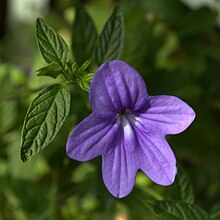
Veronica sect. Hebe is a group of plants within the genus Veronica, native to New Zealand, Rapa in French Polynesia, the Falkland Islands and South America. It was formerly treated as the separate genus Hebe. It includes about 90 species. Almost all species occur in New Zealand, apart from Veronica rapensis and Veronica salicifolia, found in South America. It is named after the Greek goddess of youth, Hebe. Informally, species in the section may be called shrubby veronicas or hebes.

Phlox is a genus of 68 species of perennial and annual plants in the family Polemoniaceae. They are found mostly in North America in diverse habitats from alpine tundra to open woodland and prairie. Some flower in spring, others in summer and fall. Flowers may be pale blue, violet, pink, bright red, or white. Many are fragrant.

Callirhoe is a genus of flowering plants in the mallow family, Malvaceae. Its nine species are commonly known as poppy mallows and all are native to the prairies and grasslands of North America. Of the nine species, some are annuals while others are perennial plants.

Hyacinthus is a small genus of bulbous herbs, spring-blooming perennials. They are fragrant flowering plants in the family Asparagaceae, subfamily Scilloideae and are commonly called hyacinths. The genus is native predominantly to the Eastern Mediterranean region and Afrotropical realm, although naturalized more widely.

Dictamnus albus is a species of flowering plant in the family Rutaceae. It is also known as burning bush, dittany, gas plant or fraxinella. This herbaceous perennial has several geographical variants. It is native to warm, open woodland habitats in southern Europe, north Africa and much of Asia.
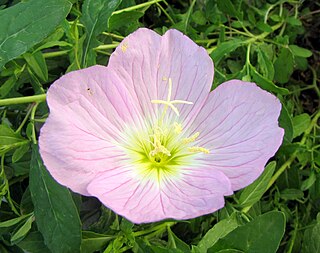
Oenothera speciosa is a species in the evening primrose family known by several common names, including pinkladies, pink evening primrose, showy evening primrose, Mexican primrose, and buttercups.

Campanula glomerata, known by the common names clustered bellflower or Dane's blood, is a species of flowering plant in the genus Campanula, belonging to the family Campanulaceae. It is the county flower of Rutland, England.

Lagerstroemia speciosa is a species of Lagerstroemia native to tropical southern Asia. It is a deciduous tree with bright pink to light purple flowers.
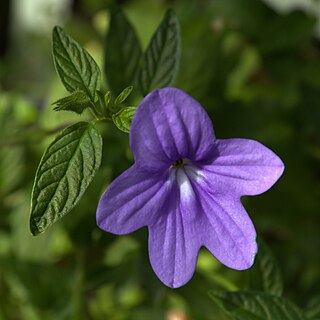
Browallia is a small genus of seven species of flowering plants belonging to the nightshade family Solanaceae. It is named after Johannes Browallius (1707–1755), also known as Johan Browall, a Swedish botanist, physician and bishop. The genus is closely related to the monotypic genus Streptosolen, the single species of which was published initially under the name Browallia jamesonii.
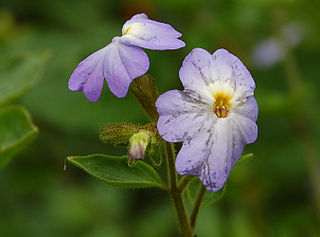
Browallia americana, the Jamaican forget-me-not, amethyst flower, or bush violet, is a species of flowering plant. It is native to tropical Latin America, from Mexico and the Caribbean, south to Peru and Brazil. Forms are variable. Pictured is the broader-leaved form.

Bush violet or bush-violet is a common name for several plants and may refer to:

Gambelia speciosa, previously classified as Galvezia speciosa, is commonly known as showy island snapdragon or showy greenbright.

Asclepias speciosa is a milky-sapped perennial plant in the dogbane family (Apocynaceae), known commonly as the showy milkweed and is found in the western half of North America.

Johannes Browallius, also called John Browall, was a Finnish and Swedish Lutheran theologian, physicist, botanist and at one time friend of Swedish taxonomist Carl Linnaeus.

Guettarda speciosa, with common names sea randa, or zebra wood, is a species of shrub in the family Rubiaceae found in coastal habitats in tropical areas around the Pacific Ocean, including the coastline of central and northern Queensland and Northern Territory in Australia, and Pacific Islands, including Micronesia, French Polynesia and Fiji, Malaysia and Indonesia, Maldives and the east coast of Africa. It reaches 6 m in height, has fragrant white flowers, and large green prominently-veined leaves. It grows in sand above the high tide mark.

Medinilla magnifica, the showy medinilla or rose grape, is a species of epiphytic flowering plant, of the family Melastomataceae, native to the Philippines. Various cultivars and hybrids of this species, genus and family are well-known and have grown to be popular with plant collectors; the species Medinilla speciosa is equally as popular.

Salvia is the largest genus of plants in the sage family Lamiaceae, with nearly 1000 species of shrubs, herbaceous perennials, and annuals. Within the Lamiaceae, Salvia is part of the tribe Mentheae within the subfamily Nepetoideae. One of several genera commonly referred to as sage, it includes two widely used herbs, Salvia officinalis and Salvia rosmarinus.

Lespedeza leptostachya is a rare species of flowering plant in the legume family known by the common names prairie lespedeza and prairie bush-clover. It occurs in the Upper Midwest region of the United States. The flowers are creamy-white to purplish and arranged into a narrow terminal spikes.
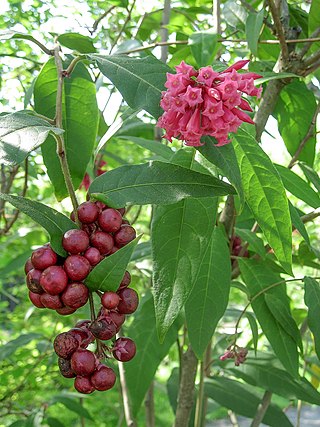
Cestroideae is a subfamily of the plant family Solanaceae, the nightshades.

Telekia speciosa, also known as the heart-leaved oxeye or yellow oxeye, is a species of flowering plant within the family Asteraceae.
